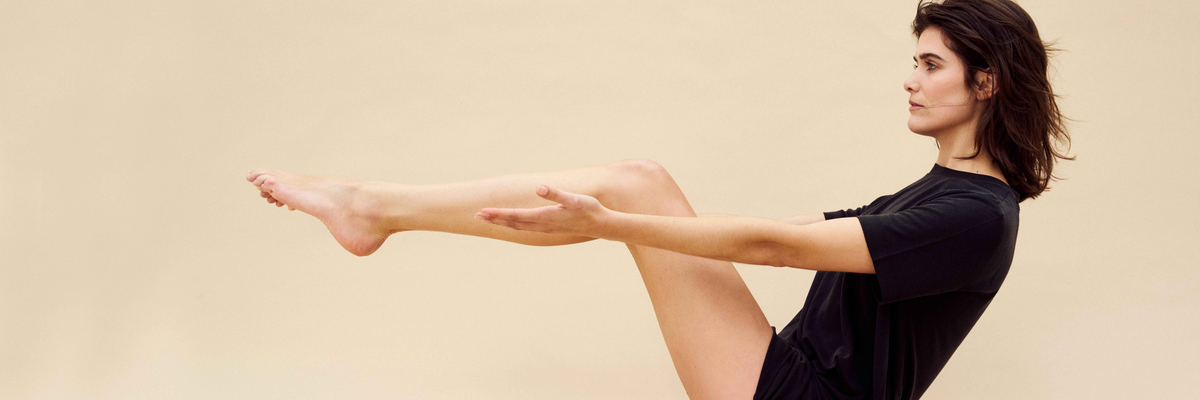
Yoga: Calm Your Overstimulated Nervous System and Reduce Stress
Yoga leads you to a state of deep relaxation. Many people practice yoga to switch off for a while. Yet, even after a physically demanding class, you step off the mat feeling rejuvenated. But how does this happen? Yoga restores an important balance in your body: that between the two sides of your nervous system. The sympathetic ('on' mode) and parasympathetic nervous systems ('off' mode) are brought into harmony through yoga, benefiting your health. The beneficial effects of yoga continue long after you leave the mat.
Sympathetic and Parasympathetic: Two Sides of the Nervous System
Our 'on' and 'off' states are regulated by our nervous system. The sympathetic and parasympathetic nervous systems are two sides of this system. Both are equally important for our health.
Sympathetic Nervous System
The sympathetic nervous system represents the 'on' mode. You are alert, your muscles are tense, and adrenaline flows through your body. This is incredibly useful when you want to perform, meet a deadline, or even just get out of bed in the morning.
Parasympathetic Nervous System
When you activate your parasympathetic nervous system, your recovery system kicks in. This allows your digestion to start, you feel content, your heart rate and blood pressure decrease, and your body has time to grow (including your hair and nails). Both sides of our nervous system are therefore important for our health. The balance between the two is essential, and this balance is something we all too easily lose sight of in today’s society. We have forgotten that periods of being 'on' should be followed by deep rest. Yoga is the perfect opportunity for your body to relearn this switching.
Balance Your Nervous System with Yoga
Some elements of yoga specifically stimulate the 'on' state. They make your heart beat faster and challenge you. Think of the sun salutation, many standing poses like the tree pose, and even the Kapalbhati breathing technique, which emphasises powerful exhalation. Other elements help your body enter the parasympathetic rest mode. In Yin yoga, where you hold poses for a long time, these elements are central. But you can find these calming 'building blocks' in all other styles as well. Consider inverted poses such as Adho Mukha Svanasana (downward-facing dog), Eka Pada Adho Mukha Svanasana (three-legged dog), and Salamba Sirsasana (headstand).



From left to right; Tree pose, headstand, three-legged dog
Learn to switch between exertion and deep relaxation.
The beauty of yoga, compared to other sports or forms of exercise, is that you are constantly training yourself to switch between the sympathetic and parasympathetic systems. For example, when a standing sequence (sympathetic) is alternated with a downward-facing dog, which you hold for several breaths (parasympathetic).
Yoga for a Calm Nervous System
Yoga keeps not only your body but also your nervous system flexible. The constant switching between exertion and relaxation ensures that you balance both your sympathetic and parasympathetic nervous systems. Here’s how you can use yoga for a calm and balanced nervous system:
- Regularly do a mini flow at home. Start with four rounds of the sun salutation. You have now activated your sympathetic nervous system and notice your heart rate increasing. Then lie in Savasana (corpse pose) for one or two minutes before possibly continuing. Feel the tension melt away and your heart rate effortlessly calm down. You are now switching to your parasympathetic system.
- Think of a challenging pose you have not yet mastered and believe you never will, such as Salamba Sirsasana (headstand) or Mukta Hasta Sirsasana A (Tripod). Make a plan (preferably with a yoga teacher) to master the pose. Which muscles do you need to strengthen for it? What preconceptions do you need to let go of? Work on this daily (preferably outdoors when possible).
- Consider what your favourite yoga style is at the moment and explore whether it provides a good balance for your nervous system. Do you mainly practice Yin Yoga? Where do you get your exertion, strength training, and challenge from? Perhaps you can add the sun salutation? In Ashtanga and Vinyasa Flow yoga, you mainly work on your sympathetic system. So, if you have a busy life and find it difficult to relax, this can be a first step. Hatha Yoga and Iyengar yoga are styles where the switch between sympathetic and parasympathetic is constantly addressed.



From left to right; cross-legged seat, tripod, downward-facing dog
3 Tips for Working on Your Nervous System
In your daily life, you can apply the insights about the nervous system and how yoga influences it. Especially if you practice yoga regularly, your body will now better know how to switch between being on and off. Additionally, you can progress with awareness, breathing, and healthy nutrition.
-
Awareness and Breathing Exercises
Have you worked hard to meet a deadline? Then give yourself a moment of rest afterwards. Your breathing is one of the best ways to calm your nervous system. Simply by breathing in and out for the same length of time, you tell your body that you are ready to enter rest mode. Another option is to stare into space or go into nature and consciously look and smell. -
Healthy Nutrition for Calm Intestines
Our intestines are also known as our second brain. Ensure that you avoid foods your body perceives as stress, such as sugars, caffeine, and alcohol, and give your intestines as much rest as possible with homemade food rich in vegetables.
Good to Know
Yoga is more than just a way to get your body moving; it is a powerful tool to balance your nervous system. This is because yoga is the ideal way to learn to switch between the sympathetic and parasympathetic nervous systems. A daily mini flow or discovering a new yoga style can help you integrate yoga into your daily life. Want to work on your nervous system in other ways? Then breathing exercises and healthy nutrition are a good start. Balance your nervous system, and you will find that you can manage stress (better).
Sources
- Ram Jain & Kalyiani Hauswirth-Jain (2017) Hatha Yoga for Teachers & Practitioners.
- Babbar, S (Babbar, Shilpa); Renner, K (Renner, Kathryn); Williams, K (Williams, Karen) (2019) Addressing Obstetrics and Gynecology Trainee Burnout Using a Yoga-Based Wellness Initiative During Dedicated Education Time
- Sarika Arora and Jayashree Bhattacharjee (2019) Modulation of immune responses in stress by Yoga
- Josefien J. F. Breedvelt, Yagmur Amanvermez, Mathias Harrer, Eirini Karyotaki, Simon Gilbody, Claudi L. H. Bockting, Pim Cuijpers, and David D. Ebert (2019) The Effects of Meditation, Yoga, and Mindfulness on Depression, Anxiety, and Stress in Tertiary Education Students: A Meta-Analysis
- Paul Cook, Spiegoloog (2019) Orgasms for Anxiety? The Unusual Suspects







